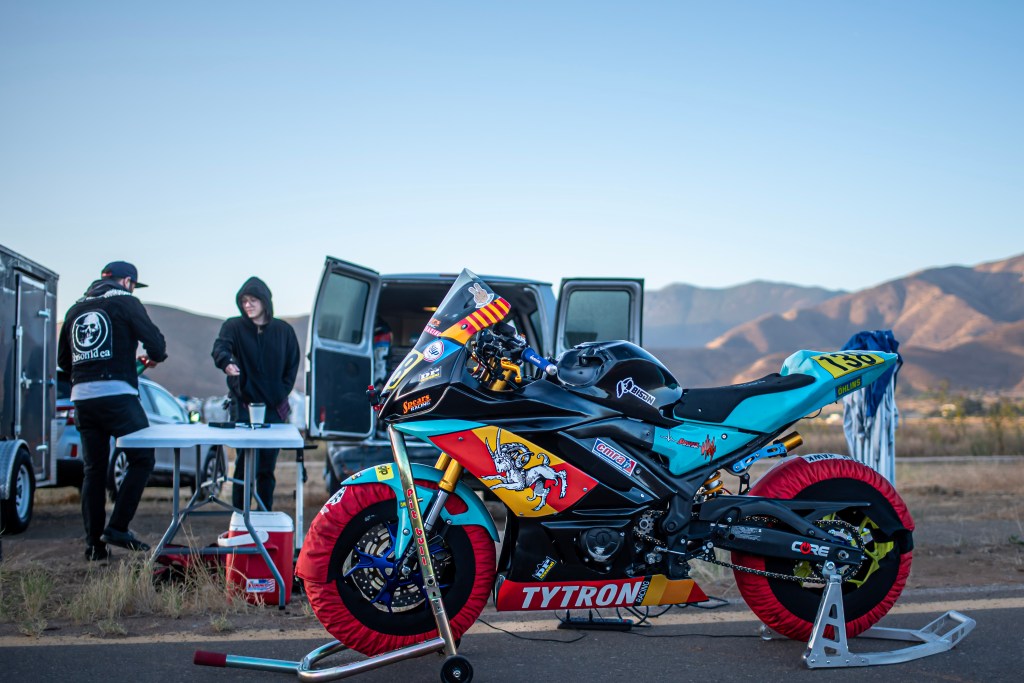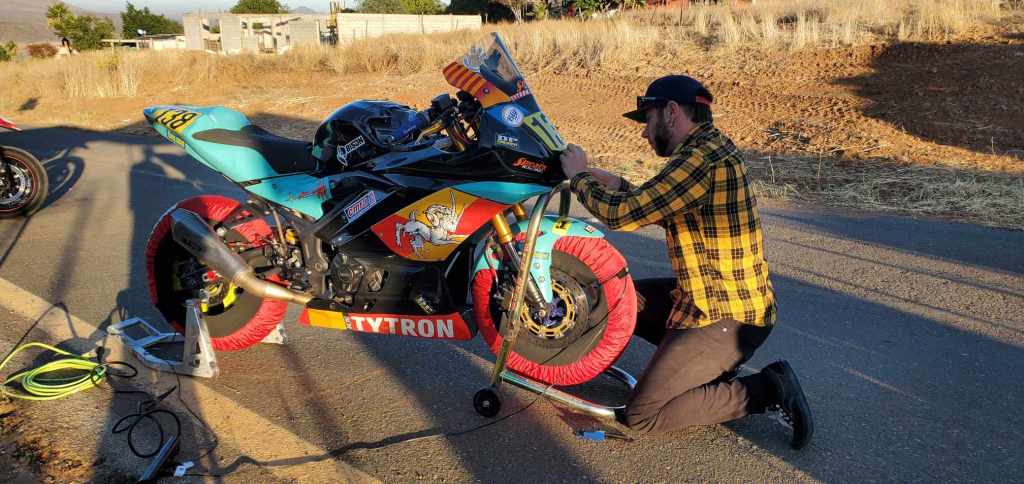
Part I – Clock’s Ticking
October 2nd 2023 06:30 A.M.
The morning ritual of cycling fluids through my body is in full effect. A dose of scalding coffee proceeded by the reminder to keep hydrating a few minutes later. Lather, rinse, repeat. My nerves are getting the best of me; Anxious sipping habits mean that I’m going to have to utilize the porta-john about seven more times before the almighty green flag drops and I’m thus catapulted down a public, two-lane, paved farm road at 115 miles per hour.
Parked next to me is the only other 300cc rider, Matt Young, who’s driven the saga of four days total to make it from D.C. to Tecate, MX. Even though we’re competitors we’re comparing notes on our bikes, sharing tid-bits of info on our respective set-ups and telling the occasional story while we set up our temporary pit-lane. I can tell through the nervousness we’re both sort of prodding each other to find out who has the competitive edge. He calls me “the faster one” but I quickly respond that he’s got two years of experience on these roads racing, and I’m the newcomer. Matt flashes a sly grin and I chuckle, waddling my leather-clad ass to the bathroom one more time.

In the cold desert morning the sun finally began to peak its way above the nearby mountainous terrain.
The main concern was getting the tire warmers on before our first session went live and the Federales temporarily closed off the four lanes of traffic. The temperature of the road surface being around 45 degrees Fahrenheit and the air temperature much, much colder. I had to ask myself; Would my small machine even be able to keep any sort of heat in the tires over 50 total miles? How much trust could really be placed in the compound leaned over in those fast corners? My mind was a whirlwind of questions leading up to this. Nothing like trial by fire.
Luckily for myself, a few of the tracks I’ve raced on in the previous years weren’t blessed with gloriously paved surfaces. They were littered with cracks and pot holes, tar snakes and turtles, pavement changes mid-apex, and the hidden bumps and undulations you only noticed when you really cracked down and pushed your pace. Endurance racing in southern Texas, I had already tested the limits of machine and rider on 32 degree temperatures for hours at a time. I had told myself and others this was a good starting point in expectations for the Tourist Cup. I won’t lie, but hidden among that slight confidence was loads of worry and doubt.
I wouldn’t ultimately know until 8 A.M. when our first session began and I was wringing the throttle and feathering the clutch in second gear. Quickly through the gearbox into sixth, you’re hanging on to the RPMs wide open, as the pavement dips once, twice, through the slight turn right, then a third drop off and into a mangled section of road over a hill. My steering stabilizer is begging for mercy as the front wheel gets lighter and the bike unsettles, throwing itself into a near tank-slapper. There’s no race line here, sonny; The weight of the chaos in Mexico is surely resting on your shoulders now, and the internal conflict against safety and maintaining momentum is a hard-fought battle, and we’ve still 9 more miles to go.
A week before the Baja Tourist Cup and I’m sitting in my garage with my feet kicked up on the work bench scouring ideas of what’s left to be done to the bike. Preparing for an event like this was much different than the usual work for my club racing events. In fact, I had been using my short track races for the past six months to get the machine ready and make sure everything was absolutely perfect. Two months prior, the 415 chain had snapped on the last lap of a very competitive 500cc class race. The result of which had sent me head over handlebars and destroyed the swingarm and some bodywork. Luckily, the chain had wrapped itself on the rear hub instead of the front sprocket which would have more than likely punched a hole in the engine casing.
The move to a 520 chain setup had been subsequently made, testing those waters in an AHRMA event the following month. The difference of the rotational weight savings weren’t apparent on track, but my lap times could tell the story much differently. Still, I had managed to pull off 6th place overall on a grid of about 30 lightweight modern race bikes, holding a candle against the flames of the faster 400cc machines.
Here I sat though in my shop; I had everything fixed up, checking every nut and bolt multiple times and safety wiring to perfection. I could buy a decent six-pack of lager with the amount of nickels and dimes I had thrown at every aspect of my bike, preparing for this single event at the close of the season. Taking a lasting, long swig I sat the empty Modelo on the bench. The biggest question still loomed in the front of my brain; “What fucking gearing will work on this course?” I had produced gearing charts with expected GPS speeds and ratios and purchased every relative sprocket from my supplier.
Thankfully, my parts company had the tallest gearing available by one tooth in the rear. Comparing notes to my 415 chain chart, I could have went a lot taller and had more options between ratios, but the ultimate risk of another catastrophic event on a public road race course wasn’t an option at this point. It was too bad honestly, because my competitive mind told me to save that rotational weight, gain much needed power, and have many more options to choose from. I had been asking everyone I knew with decades more than me of racing experience what their thoughts might be in a starting point for gearing on a long, ten-mile race course full of hills and miles of long straightaways. I was met with shrugs and diversions, responses I was familiar with, like asking the seasoned racers at my local club to join me on my trip to Mexico for this event.
“They must think I’m absolutely insane”
This was just something I’d have to figure out myself. In my experience, win or lose, those trials are often rewarding enough in themselves. The knowledge from our failures only help secure our future successes. They force us to dig deeper, they test our fortitude and will. They jettison our desire forward, hopefully checking our egos along the way. They prove not only to ourselves, but to others, how we genuinely love what we do. Analyzing those moments are what allow us to grab the brakes a fraction of a second later, open the throttle a bit sooner, and grab that extra shift up in the corner.
So, I slapped some sprockets on the bike, loaded everything up, and tried to calm my excitement enough to get some sleep before the 24 hour drive to the border.
